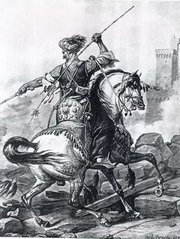Mamluk
|
|
Mamluks (also Mameluks, Mamelukes) (the Arabic word usually translates as "owned", singular: مملوك plural: مماليك) comprised slave soldiers used by the Muslim caliphs and the Ottoman Empire, and who on more than one occasion seized power for themselves.
The first Mamluks worked for Abbasid caliphs in 9th century Baghdad. The Abbasids recruited them from enslaved non-Muslim families captured in areas including modern Turkey, Eastern Europe, and the Caucasus. Using non-Muslims as soldiers helped partially overcome Islamic prohibitions on Muslims fighting each other. The rulers also desired troops with no link to the established power structure. The local warriors were often more loyal to their tribal sheiks, their families or nobles other than the sultan or caliph. If some commander conspired against the ruler, it was often not possible to deal with him without causing unrest among the nobility. The slave-troops were strangers of the lowest possible status who could not conspire against the ruler and who could easily be punished if they caused trouble.
After being converted to Islam, they were trained as cavalry soldiers, while technically after training they were no longer slaves they were still obliged to serve the Sultan. They were kept by the Sultan as an outsider force, under their direct command, to use in the event of local tribal frictions. Many Mamluks rose to high positions throughout the empire, including commanderships. Status remained non-hereditary at first and children were strictly prevented from following their fathers. The intensive and rigorous training given to each new recruit helped ensure a great deal of continuity in Mamluk practices.
| Contents |
Mamluks in Egypt
Two Mamluk dynasties ruled Egypt: the Bahri (بحري meaning 'of the sea', referring to their center in al-Manial Island in the Nile, and consisting of Turks and Mongols) and Burji (برجي meaning 'of the tower', referring to their center in the citadel of Cairo, and consisting of Circassians and Georgians). The Bahri led the way in breaking the rule of non-hereditary positions by establishing a dynasty ruled by a few families. Through this period and until the 19th century, the Mamluk dynasties continued to increase their numbers by purchasing more slave soldiers.
The Mamluk dynasties of Egypt were instrumental in defeating the invading Mongol army, the Mamluk forces being under Qutuz at the time. The Mamluk dynasties were also central in eliminating the last remnants of the Crusaders from Egypt and Syria under Baibars, Qalawun, and Khalil.
The influence of the Mamluk dynasties on Syria and Egypt is still evident today in the architecture of mosques, schools, and libraries, as well as bridges, water fountains and other public works.
In 1517, Egypt was taken over by the Ottoman Empire. The Mamluks remained in charge of the state, which retained much autonomy from Constantinople.
In 1768, Sultan Ali Bey Al-Kabir declared independence from the Ottomans but the Mamluks crushed the movement and retained their position after his defeat. By this time new slave recruits were introduced from Georgia in the Caucasus. Napoleon defeated Mamluk troops when he attacked Egypt in 1798 and drove them to Upper Egypt. By this time Mamluks had added only muskets to their typical cavalry charge tactics.
After the departure of French troops in 1801, Mamluks continued their struggle for independence, this time against the Ottoman Empire and Great Britain. It is noteworthy that in 1803, Mamluk leaders Ibrahim Beg and Usman Beg wrote a letter to Russian general-consul and asked him to act as a mediator with the Sultan as they wanted a cease fire and return to their homeland, Georgia. The Russian Ambassador in Istanbul categorically refused to mediate because the Russian government was afraid of allowing Mamluks to return to Georgia, where a strong national-liberation movement was on rise and the Mamluk return would have empowered it.
In 1805, the population of Cairo rebelled. There was an excellent opportunity for the Mamluks to seize the state authority, but the tension among them and betrayal by some Mamluks did not allow them to exploit this opportunity. In 1806, the Mamluks defeated the Turkish forces several times, and in June confronting parties concluded a peace treaty, according to which Muhammad Ali (appointed as governor of Egypt on 26 March 1806) was to be removed and the state authority in Egypt returned to the Mamluks. But again, internal tension and conflicts between the clans did not allow the Mamluks to use this opportunity. Muhammad Ali kept his authority and this would be fatal for the Mamluks.
Muhammed Ali knew that eventually he would have to contend with the Mamluks if he ever wanted to control Egypt. They were still the feudal owners of Egypt and their land was still the source of wealth and power in Egypt. In 1809–1810, Muhammad Ali managed to split the Mamluks, one part of them went to Sudan and settled there. Finally, on 1 March 1811, Muhammad Ali invited all Mamluks to his palace to celebrate the declaration of war against the Arabs. There were nearly 600 Mamluks (in another source about 700) on parade in Cairo, when near the Al-Azab gates, in a narrow road down from Mukatamb Hill, Muhammad Ali's forces ambushed and slaughtered almost everyone. According to the tradition, only one Mamluk named Hasan survived, as he cut his way though the Turks and jumped with a horse over a precipice to freedom.
Throughout the following week hundreds of Mamluks were killed throughout Egypt. In the citadel of Cairo more than 1000 Mamluks were murdered, while in the streets about 3,000 Mamluks and their relatives were massacred. One little group of Mamluks escaped to Sudan and settled in a little village of Dongola. Many of them died within 2 or 3 years (among them Ibrahim Beg, who died in 1816). In 1820, Muhammad Ali pardoned them and allowed them to return to Egypt, but only 80 Mamluks crossed the border.
Mamluks in France
Napoleon formed his own Mamluk corps in the early years of the 19th century, the last known Mamluk force. Even his Imperial Guard had Mamluk soldiers during the Belgian campaign, including one of his personal servants. After the Battle of Austerlitz (2 December 1805), they gained their own regimental standard. Napoleon's famous bodyguard Roustan was also a Mamluk from Egypt.
One of the pictures by Francisco de Goya shows a charge of Mamluks against the Madrilene on 2 May 1808.
Throughout the Napoleonic era, there was a special Mamluk corps in the French army. In his history of the 13th Chasseurs, Colonel Descaves recounts the use of Mamluks by the young General Bonaparte in Egypt. In his so-called "Instructions", which Bonaparte gave to Kleber after departure, Napoleon wrote that he had already bought about 2,000 Mamluks from Syrian merchants from whom he intended to form a special detachment. On 14 September 1799, General Kleber established a mounted company of Mamluk auxiliaries and Syrian janissaries from Turks captured at the siege of Acre. On 7 July 1800, General Menou reorganized the company, forming 3 companies of 100 men each and renaming it the "Mamluks de la Republique". In 1801, General Rapp was sent to Marseille to organize a squadron of 250 Mamluks under his command. On 7 January 1802, the previous order was canceled and the squadron reduced to 150 men. The list of effectives on 21 April 1802 reveals 3 officers and 155 rank and file. By decree of 25 December 1803, the Mamluks were organized into a company attached to the Chasseurs-a-Cheval of the Imperial Guard.
They performed well at Austerlitz (2 December 1805) and were granted a standard and a roster increased to accommodate a standard bearer and a trumpet. A decree of 15 April 1806 defined the strength of squadron as 13 officers and 147 privates, while in 1813 its Chasseurs-a-Cheval of the Imperial Guard. A decree of 17 March established another company attached to the Young Guard. With the First Restoration, the company of the Mamluks of the Old Guard was incorporated in the Corps Royal des Chasseurs de France. The Mamluks of Young Guard were incorporated in the 7th Chasseurs a Cheval.
Despite the Imperial decree of 21 March 1815 which stated that no foreigner could be admitted into the Guard, Napoleons decree of 24 April prescribed inter alia that the Chasseurs-a-Cheval of the Imperial Guard included a squadron of two companies of Mamluks for the Belgian Campaign.
Mamluk uniform
During their service in Napoleons army, the Mamluk squadron wore the following uniform:
Before 1804: The only "uniform" part was the green cahouk (hat), white turban, and red saroual (pants), all to be worn with a loose shirt and a vest. Boots were of yellow or red or tan soft leather. Weapons, an "Oriental" scimitar, a brace of pistols in a holder decorated with a crescent and a star, in brass, and a dagger.
After 1804: The cahouk became red with a brass crescent and star, and the shirt was closed and had a collar. The main change was the addition of a "regulation" chasseur style saddle cloth and roll, imperial green in color, piped red, with a red and white fringe. The saddlery and harness remained Arabic in style. The undress uniform was as for the Chasseurs-a-Cheval of the Guard but of a dark blue cloth.
Mamluks in Baghdad
In the Ottoman Empire, Mamluks of Baghdad proclaimed their independence in the 18th century and remained autonomous until the Ottoman reconquest in 1832.
Mamluks in India
In 1211, the Mamluk commander of the Muslim forces in India, Qutbuddin Aibak, proclaimed himself sultan, becoming, in effect, the first independent Sultan-e-Hind. This Mamluk dynasty lasted until 1290. See Delhi Sultanate for more information.
Other slave soldiers
Other Islamic states used slave soldiers: note the janissaries of the Ottoman Empire and the saqaliba of Andalusi taifas, especially in Denia.
Related terms
Mameluco is a Portuguese word used to identify people of mixed European and Native American descent in South America. In the 17th and 18th centuries, Mameluco referred to organized bands of Portuguese slave-hunters, also known as bandeirantes, who roamed the vast interior of South America from the Atlantic to the slopes of the Andes, and from the Paraguay to the Orinoco Rivers, raiding the Guarani-inhabited areas for slaves.
External links
- Catholic Encyclopedia: Mameluco (http://www.newadvent.org/cathen/09578c.htm)
- Mamluks—Military slave dynasty (http://www.islamicarchitecture.org/dynasties/mamluks.html)
- Arts of the Mamluks (http://www.saudiaramcoworld.com/issue/198106/art.of.the.mamluks.htm)
- Arts of the Mamluks (http://www.islamicity.com/Culture/atm/atm.htm)de:Mamluken
fr:Mamelouks he:ממלוכים nl:Mamelukken ja:マムルーク pl:Mamelucy pt:Mameluco


